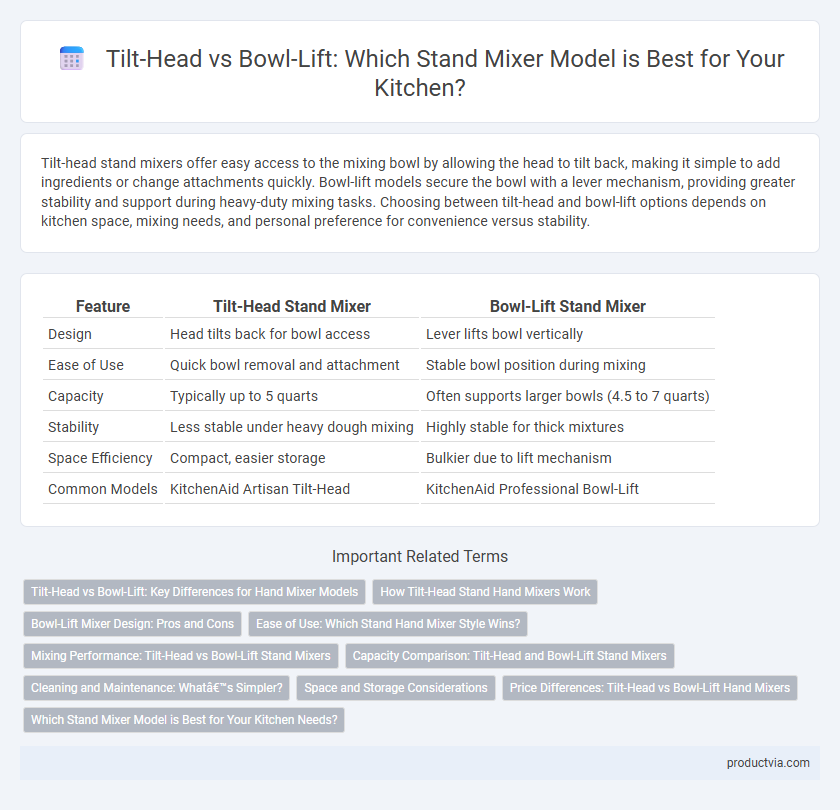Tilt-head stand mixers offer easy access to the mixing bowl by allowing the head to tilt back, making it simple to add ingredients or change attachments quickly. Bowl-lift models secure the bowl with a lever mechanism, providing greater stability and support during heavy-duty mixing tasks. Choosing between tilt-head and bowl-lift options depends on kitchen space, mixing needs, and personal preference for convenience versus stability.
Table of Comparison
| Feature | Tilt-Head Stand Mixer | Bowl-Lift Stand Mixer |
|---|---|---|
| Design | Head tilts back for bowl access | Lever lifts bowl vertically |
| Ease of Use | Quick bowl removal and attachment | Stable bowl position during mixing |
| Capacity | Typically up to 5 quarts | Often supports larger bowls (4.5 to 7 quarts) |
| Stability | Less stable under heavy dough mixing | Highly stable for thick mixtures |
| Space Efficiency | Compact, easier storage | Bulkier due to lift mechanism |
| Common Models | KitchenAid Artisan Tilt-Head | KitchenAid Professional Bowl-Lift |
Tilt-Head vs Bowl-Lift: Key Differences for Hand Mixer Models
Tilt-head and bowl-lift are the two primary designs for stand mixer heads, offering distinct operational mechanics and user experiences. Tilt-head models allow the mixer head to pivot backward, providing easy access to the bowl and beaters for adding ingredients and cleaning, while bowl-lift mixers feature a lever that raises and lowers the bowl, ensuring a more stable mixing environment ideal for heavier doughs. Tilt-head mixers tend to be more compact and versatile for everyday baking tasks, whereas bowl-lift mixers provide enhanced durability and power suited for frequent, large-batch mixing.
How Tilt-Head Stand Hand Mixers Work
Tilt-head stand mixers feature a motorized base with a hinged head that lifts backward to provide easy access to the mixing bowl and attachments. The tilt-head mechanism allows users to quickly change beaters, whisks, or dough hooks while keeping the bowl stationary on the base. This design offers convenient, hands-free mixing and easy cleaning compared to bowl-lift models, which raise the bowl for ingredient incorporation.
Bowl-Lift Mixer Design: Pros and Cons
Bowl-lift hand mixer models feature a sturdy arm mechanism that raises and lowers the mixing bowl, offering stability for heavy doughs and large batches, making them ideal for professional or frequent bakers. This design provides strong support during intensive mixing tasks, reducing bowl movement and ensuring consistent ingredient incorporation, but it tends to have a larger footprint and limited bowl size compatibility compared to tilt-head mixers. Maintenance can be more complex due to the arm mechanism, and these mixers often come at a higher price point, balancing durability and performance with cost and space considerations.
Ease of Use: Which Stand Hand Mixer Style Wins?
Tilt-head stand mixers offer superior ease of use with quick access to the mixing bowl, allowing for effortless attachment changes and ingredient additions without lifting heavy components. Bowl-lift models provide sturdier support for heavy doughs but require manual lifting, which can be less convenient during prolonged mixing tasks. For users prioritizing seamless operation and speed, tilt-head mixers generally deliver a more user-friendly experience.
Mixing Performance: Tilt-Head vs Bowl-Lift Stand Mixers
Tilt-head stand mixers offer easy access to the mixing bowl, allowing quick ingredient addition and tool changes, but may have slightly less powerful mixing performance due to less bowl stability. Bowl-lift stand mixers provide superior stability by securely locking the bowl in place, resulting in more efficient mixing and better handling of heavy doughs or large batches. For optimal mixing performance, bowl-lift models excel in heavy-duty tasks while tilt-head mixers are suited for lighter, everyday mixing needs.
Capacity Comparison: Tilt-Head and Bowl-Lift Stand Mixers
Tilt-head stand mixers typically accommodate smaller bowl capacities, ranging from 3 to 5 quarts, making them ideal for everyday baking tasks and lighter mixing. Bowl-lift models support larger capacities, often between 4.5 and 7 quarts, allowing for greater volume and heavy-duty mixing suitable for professional or large-batch baking. Capacity differences influence the choice based on intended use, with bowl-lift mixers preferred for complex doughs and extensive recipes due to their stability with larger bowls.
Cleaning and Maintenance: What’s Simpler?
Tilt-head stand mixers offer easier access to the mixing bowl and attachments, simplifying cleaning and maintenance by allowing users to lift the head and remove parts with minimal effort. In contrast, bowl-lift models require lowering the bowl clip before detaching the bowl, which can make cleaning slightly more cumbersome but often provides a more stable mixing experience. Overall, tilt-head mixers are generally considered simpler to clean and maintain due to their straightforward design and accessibility.
Space and Storage Considerations
Tilt-head stand mixers typically require less kitchen counter space due to their compact design, allowing the head to easily lift without additional clearance. Bowl-lift mixers have a fixed head and utilize a lever to raise and lower the bowl, which may demand more vertical space for operation and storage. Choosing between tilt-head and bowl-lift models depends on available kitchen storage and countertop space, as tilt-heads are generally more space-efficient.
Price Differences: Tilt-Head vs Bowl-Lift Hand Mixers
Tilt-head stand hand mixers generally come at a lower price point compared to bowl-lift models due to their simpler design and ease of manufacturing. Bowl-lift mixers, favored for their stability and capacity to handle heavier doughs, tend to be more expensive because of additional features like a lever mechanism and robust build materials. Consumers looking for budget-friendly options often choose tilt-head mixers, while professionals investing in durability and performance prefer bowl-lift models despite the higher cost.
Which Stand Mixer Model is Best for Your Kitchen Needs?
Tilt-head stand mixers offer easy access to the mixing bowl, making them ideal for smaller kitchens and casual bakers seeking convenience and flexibility. Bowl-lift models provide superior stability and strength, preferred by serious bakers handling heavy doughs or large batches. Choosing between tilt-head and bowl-lift depends on kitchen space, mixing frequency, and recipe complexity, ensuring the best fit for your culinary demands.
Tilt-Head vs Bowl-Lift for Stand Hand Mixer Models Infographic

 productvia.com
productvia.com